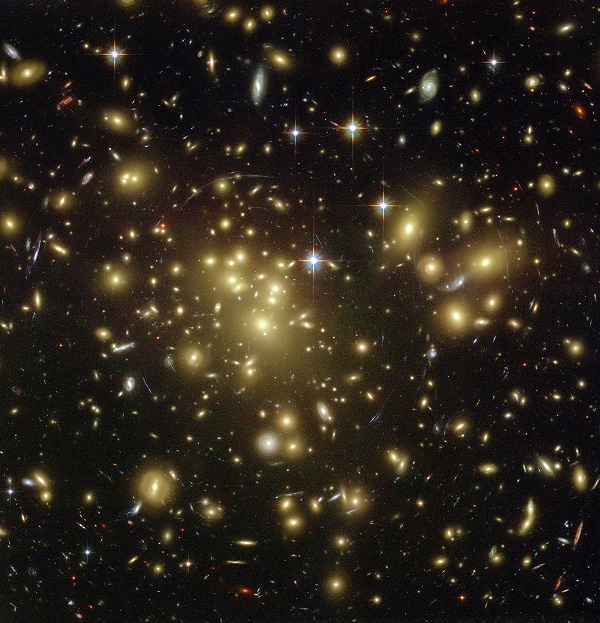Scientists Discover 'Dusty Galaxy' Formed When Universe was Just 700 Million Years Old
| Ana Verayo | | Mar 03, 2015 08:29 AM EST |
(Photo : NASA ; ESA ; L. Bradley (Johns Hopkins University ) ; R. Bouwens (University of California, Santa Cruz) ; H. Ford (Johns Hopkins University ) ; and G. Illingworth (University of California, Santa Cruz)) New observations made with ALMA and the VLT ESO telescope revealed that this object is a dusty galaxy born when the universe was only 700 million years old.
Astronomers have just discovered a galaxy so ancient it possesses a family of stars that has existed since the dawn of time. Most of the earliest galaxies show little stellar activity but this one -- A1689-zD1 located on the edge of the universe -- is highly active and exudes massive amounts of dust.
Like Us on Facebook
This cosmic dust consists of carbon, oxygen, silicon and magnesium among many other elements not commonly observed in older galaxies. Infant galaxies, on the other hand, are devoid of these materials.
These elements originate from the cores of stars and they spread throughout space and become seeds that form new generations of stars. Astronomers believe galaxies have to go through seven generation of stars for cosmic dust to accumulate and build-up in large concentrations.
The cluster of galaxies called Abell 1689 apparently has a gravitational lens. This means that gravity from the group of stars bends light like a lens, acting like a telescope that magnifies the image of the galaxy more than nine times.
This ancient galaxy was imaged by the ALMA telescope (Atacama Large Millimeter/submillimeter Array) and the X-shooter instrument of the European Southern Observatory's Very Large Telescope in Chile. The observations revealed a massive amount of cosmic dust shrouding this family of stars.
Light from distant objects in the cosmos take light years to reach Earth. Galaxy A1689-zD1 is so distant, however, that astronomers are seeing stars that existed when the Universe was just 700 million years old.
According to Darach Watson of the University of Copenhagen, the exact origin of the galactic dust is still obscure but findings indicate this production happened very rapidly, within 500 million years into the first star formations of the Universe. This is a short astronomical time frame as stars exist for billions of years.
This dust can also come from star bursts from a period of rapid stellar formation that was followed by a decline in stellar births. This ancient, dusty galaxy seemed to be in a hurry to form the first generations of stars to exist in the universe, according to Kirsten Knudsen from the Chalmers University of Technology in Sweden. ALMA should be able to detect more galaxies like this.
This study was published in the journal, Nature.
TagsALMA, VLT telescope, ESO, ancient old dusty galaxy early universe, Super Ancient and Dusty Galaxy Found When the Universe Was Just 700 Million Years Old
©2015 Chinatopix All rights reserved. Do not reproduce without permission
EDITOR'S PICKS
-

Did the Trump administration just announce plans for a trade war with ‘hostile’ China and Russia?
-

US Senate passes Taiwan travel bill slammed by China
-

As Yan Sihong’s family grieves, here are other Chinese students who went missing abroad. Some have never been found
-

Beijing blasts Western critics who ‘smear China’ with the term sharp power
-

China Envoy Seeks to Defuse Tensions With U.S. as a Trade War Brews
-

Singapore's Deputy PM Provides Bitcoin Vote of Confidence Amid China's Blanket Bans
-

China warns investors over risks in overseas virtual currency trading
-

Chinese government most trustworthy: survey
-

Kashima Antlers On Course For Back-To-Back Titles
MOST POPULAR
LATEST NEWS
Zhou Yongkang: China's Former Security Chief Sentenced to Life in Prison

China's former Chief of the Ministry of Public Security, Zhou Yongkang, has been given a life sentence after he was found guilty of abusing his office, bribery and deliberately ... Full Article
TRENDING STORY

China Pork Prices Expected to Stabilize As The Supplies Recover

Elephone P9000 Smartphone is now on Sale on Amazon India

There's a Big Chance Cliffhangers Won't Still Be Resolved When Grey's Anatomy Season 13 Returns

Supreme Court Ruled on Samsung vs Apple Dispute for Patent Infringement

Microsoft Surface Pro 5 Rumors and Release Date: What is the Latest?










